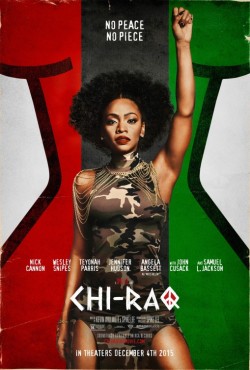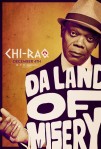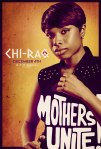 Chicago has a long and sometimes violent history. No one needs to be told about the gang violence that ravaged the city during the first part of the 20th Century, particularly during Prohibition. Different forms of violence have afflicted Chicago through the decades, many unfortunately due to its severely segregated population, a result of political decisions based either on racial prejudices, voting considerations or a combination of both. While everyone outside the city keeps images of Al Capone in their heads, residents of the area hear news reports of shootings, particularly on the south side, almost every day.
Chicago has a long and sometimes violent history. No one needs to be told about the gang violence that ravaged the city during the first part of the 20th Century, particularly during Prohibition. Different forms of violence have afflicted Chicago through the decades, many unfortunately due to its severely segregated population, a result of political decisions based either on racial prejudices, voting considerations or a combination of both. While everyone outside the city keeps images of Al Capone in their heads, residents of the area hear news reports of shootings, particularly on the south side, almost every day.
Now director Spike Lee is here with Chi-raq, a movie that attempts to shine a light on the plague of violence the city, especially the African-American population, suffers from. The name is derived from a nickname for the city meant to liken it to a similarly unsafe place to live. But the story is a loose adaptation of Aristophanes’ Lysistrata, a Greek play about a group of women who deny their men sex as a way to stop them from fighting wars. In the case of this movie Teyonah Parris plays Lysistrata, who concocts a similar movement to try and get the men of the city to put down their guns and stop killing each other as well as innocents caught in the crossfire.
The movie also has the distinction of being the first film produced and distributed by Amazon Studios. So it’s debuting in theaters at about the same time it will be available on-demand through Amazon’s video service.
The Posters
The first poster features a mash-up of three flags in the background. The image combines the format of the United States flag – the stripes and a blank field in the upper left – with the colors of the Pan-African flag as the stripes. In the field where there stars would be on the U.S. flag are just four stars, a reference to the flag of the City of Chicago. Those are just above the name of the movie along with the director’s name. In front of all that is a hand holding up two fingers in the “peace” sign, that hand also sporting the black, red and green of the Pan African flag.
The next poster puts Parris right there in the spotlight. We see her head dominating the frame in front of people holding “I am woman” and other protest signs. The cast list is at the top, just above the “No Peace, No Piece” copy that acts as a nice little nod to the story of denying sex until the violence stops. It’s enormously effective as a provocative statement as well as a glimpse into the plot.
The next poster continues many of the themes. This time Parris is seen in full in the foreground while wearing a camouflage outfit and holding up her own hand with a peace sign being flashed. In the background the black, green and red are put to use in an image of a female body that’s obviously meant to be overly-sexualized with its narrow hips and large breasts.
Three character posters were released just prior to release that take the focus off Parris and ditch some of the previous thematic elements. One has John Cusack, who plays a priest in the movie, holding a gun and with “Put down the guns” scrawled on the front of his shirt. Nick Cannon is on the next one, his hand extended toward the camera as if gripping a pistol and with “The truth shall set you free” on his shirt. The final one features Samuel L. Jackson, who plays Dolmedes, the narrator/host of the story, with “Da land of misery” on his shirt.
Similar posters were released with Bassett, Parris and Jennifer Hudson, with “Get schooled,” “No peace, no piece” and “Mother’s unite” on their shirts, respectively.
Focusing on the first three posters…I kind of love them from a marketing point of view. They’re provocative, they’re thematically consistent and they convey a strong message. You can get a lot of the movie’s story, or at least what kind of approach it’s going to take, just from those movies. It’s also great that they show off Parris since while she may not be the biggest star in the movie she certainly seems to be the main character in the story.
The Trailers
The first trailer opens by declaring the Chicago homicides have surpassed the special forces death toll in Iraq. Then we meet Jackson’s narrator/carnival barker, who welcomes us to Chi-raq. Then we move on to Lysistrata talking to a group of women about how they all have men who are putting themselves at daily risk of death on the streets. We see more about her thanks to Jackson’s narration until we see she organizes the other women to stop giving those men sexual access until they put down their guns, a situation the men aren’t thrilled with. From there out it’s lots of intercut pieces of violence, protests and more.
It’s an incredibly effective trailer, but it presents the movie as being something of a surreal farce. That’s not to say it downplays the seriousness of the subject matter, but it seems to show the movie is taking kind of a weird fantasy that shines a light on a serious subject. It’s fascinating.
Because of the reaction to the first trailer and the impression that maybe this was a comedy at some level, a second trailer was quickly released complete with an introduction by Lee that made it clear this was *not* a comedy, but a very serious movie with some elements of comedy in it.
This one was a lot more serious. It was also a lot less structured, playing more like a serious of clips than a fully edited and molded trailer. This one hits more like a gut punch than the first one, partly because of the unusual structure.
Online and Social
The official website for the movie at first features a version of the second poster’s key art.
The first section on the site is “The Story” and contains a two-paragraph synopsis of the movie that also makes it clear who all the characters are. “Music” links to a stand-alone site for the soundtrack, which also got prominent call-outs on most of the posters. The “Gallery” has a collection of stills from the movie, behind-the-scenes shots and some trailers and other videos.

“Get Involved” contains statistics on gun violence both in Chicago specifically and the U.S. in general. That then encourages you to Get Involved by joining Everytown for Gun Safety, a prevention group that is trying to pass “common sense” gun laws that can do a lot to prevent these kind of shootings, both in neighborhoods and in mass incidents that get lots of press.
“Social Chatter” features a stream of updates from the movie’s Twitter account. Finally there’s “Trailer,” which just has the first trailer.
The movie had profiles on Facebook, Twitter and Instagram.
Advertising and Cross-Promotions
There was some TV advertising done in spots that put the focus on the cast while not really focusing on the story very much at all aside from one line from Lysistrata about getting the fools to put down their guns. It’s good and shows off Jackson’s character, likely because it’s a big and showy role.
I believe there was some online and outdoor advertising done, particularly in neighborhoods that, to put it delicately, may not be filled with white people. That’s not a value judgement, just a statement that the studio may think this has a specific demographic appeal.
Media and Publicity
The movie’s first wave of press was almost uniformly negative and focused on Chicago local media. The Chicago City Council took on Lee and the movie directly, pushing for city tax credits to be revoked for its production since it portrayed the city in a negative light. Ultimately that created just more buzz for the movie and made the city look a bit clueless about the problems within its borders and more concerned with image than actually addressing the issue. That animosity would continue as Lee would call Emanuel a “bully” for trying to force out the production and he would continue his criticisms, especially in light of the news surrounding a Chicago cop shooting an unarmed teen a year ago.

Closer to release Lee would talk about the making of the movie, including how everyone else he took the idea to rejected it out of hand before Amazon agreed to help make and distribute it. That was in advance of director receive an Honorary Oscar, a platform he’d use to call for even more and greater diversity in Hollywood.
Unfortunately the director also had to answer a lot of stupid questions, including whether or not movies like this were the cause of, not a reflection of, violence and whether as a non-Chicago native he was even allowed in some way to make a movie that indicts the city like this.
Nick Cannon would be a big part of the press push, making the talk-show rounds, sometimes with Lee and Parris, sometimes on his own. Parris would also do the occasional solo interview here and there, including talking about how she hopes the movie will spur people to make a change in their own neighborhoods. Lee took part in an anti-violence march after the movie’s New York premiere to continue the theme of not just promoting the movie but pushing the agenda that’s part of the movie.
Overall
I really like this campaign and feel it does a great job of taking its intended message to the intended audience. Thematically it’s almost 100% consistent throughout all the elements of the marketing, with widespread usage of the black, green and red color palate throughout the posters, trailers and site. So on that front this is a really solid campaign.
I think what strikes me most is that unlike almost all other movie marketing campaigns, this one has something to say. And it does so strongly and without apology. There is a message in the movie and that comes through loud and clear in the marketing. The message being sold here may or may not feel relevant to you right now – it should, though – but it’s a big part of the campaign. Here’s hoping the push does more to bring in people’s interest and attention.
Want to get Movie Marketing Madness via email? Sign up here. Then connect with MMM on Twitter and Facebook.







